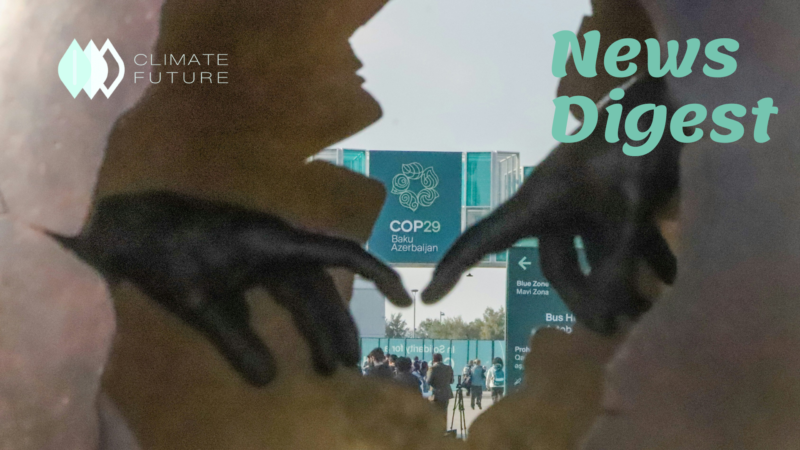Global survey reveals ‘truly astonishing’ consensus for stronger climate action

© UNICEF/Pham Ha Duy Linh
Eighty percent of participants in the Peoples’ Climate Vote 2024, a sizable climate change survey, expressed a desire for more aggressive climate change action. Participants in the study came from 77 different nations, making up 87% of the global population. According to the data, there is broad agreement on the matter, with most respondents in 62 nations favoring the move to renewable energy. Concerns about climate change are widespread; more than half of respondents indicate their concerns have increased from the previous year. The findings of the poll indicate that people’s decisions about where to live and work are being impacted by climate change. The survey’s conclusion is unambiguous: people want politicians to take decisive actions on climate change. It is believed that there is a significant window of opportunity to reduce global warming in the next two years.
Ocean investments must reach developing countries

Image: NOAA Ocean Exploration, CC BY-SA 3.0, via Flickr
The Global North, especially Europe and Central Asia, has benefited greatly from investments in the ocean’s blue economy. Of the $6 billion spent between 2017 and 2021, $4.4 billion went to these regions. Less than 10% of the funds were allocated to vital marine industries in the Global South, such as aquatic foods, while the majority went to offshore wind projects. Due to several initiatives that run the risk of privatizing public assets and excluding local populations, this imbalance endangers the rights and possibilities of coastal communities in the Global South. Three actions are needed to solve these issues: making investment flows more transparent; making sure that money is distributed fairly throughout the world; and diversifying investments across industries including climate adaptation, sustainable fisheries, and conservation. While equitable and varied funding can help the livelihoods, food security, and resilience of vulnerable coastal communities, greater openness can encourage responsibility and adherence to sustainable practices. Reaffirming goals and tactics to create a robust blue economy that benefits everyone depends on gatherings like the IIFET Conference.
Coal use in Indonesia and the Philippines reaches record levels

Image: Recourse
Indonesia and the Philippines boosted their coal dependence in 2023 despite international demands to decrease it. At 61.8% of the total energy mix, coal was used for the first time in Indonesian history, while the Philippines rose to the top of the coal-dependent countries in Southeast Asia with 61.9%. Both nations find it difficult to generate enough clean power to meet the growing energy demand. With Indonesia at 0.3% and the Philippines at 3.2% of the electricity mix, renewable energy sources like solar and wind showed sluggish development. The Philippines anticipates building new coal-fired power facilities by 2028, while simultaneously planning to retire some of them by 2027. By 2060, Indonesia hopes to have zero net emissions, but it will need financial assistance from abroad. Experts refer to subsidies for fossil fuels as obstacles to Indonesia’s adoption of renewable energy. Without financial support from abroad, Indonesia claims it cannot afford to give up coal.
China’s 2035 targets can be a climate breakthrough

Image: wong zihoo, CC BY-SA 3.0, via Unsplash.
China needs to update its 2030 promises and present the UN with its 2035 climate ambitions. Currently, China wants to reach carbon neutrality by 2060 and peak emissions by 2030. These goals are essential for China’s energy transformation and international climate efforts. China’s current promises are deemed “highly insufficient” by the Climate Action Tracker, despite the country’s recent strong growth in clean energy. China is a major player in achieving the objectives of the Paris Agreement, contributing 30% of the world’s greenhouse gas emissions. To meet the 1.5°C objective, at least a 30% reduction by 2035 is advised. There are large prospects for emissions reduction in industries like steel and power by switching to cleaner production techniques. Growth in renewable energy—especially wind and solar—is already expected to reduce the need for coal and peak power-sector emissions. By boosting the production of electric arc steel, China’s steel industry, which emits the most CO2 after the power sector, may reduce it by 40%. With continuous growth in renewable energy, the power sector might cut its coal usage by 35% by 2035. Transport, CO2 emissions trading, and cement production reductions all contribute to these objectives. Setting ambitious goals for 2035 will help China achieve its clean-tech industry-driven economic growth and cement its commitment to being carbon neutral.
References
https://news.un.org/en/story/2024/06/1151271
https://www.eco-business.com/opinion/ocean-investments-must-reach-developing-countries
https://www.eco-business.com/news/coal-use-in-indonesia-and-the-philippines-reaches-record-levels
https://www.eco-business.com/news/chinas-2035-targets-can-be-a-climate-breakthrough



